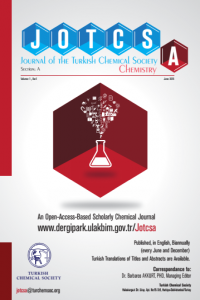Evaluation of Energy Consumption in Electrochemical Oxidation of Acid Violet 7 Textile Dye using Pt/Ir Electrodes
Abstract
The effects of process parameters were investigated on the electrochemical oxidation of textile dyeing wastewater containing Acid Violet 7 (AV7) at Pt/Ir electrodes in the presence of 75%NaCl+25%Na2CO3 (w/w) supporting electrolyte mixture in a batch electrochemical reactor. Experimental parameters were operated in the range of 300-1500 mg/L textile dye concentration, 4-20 g/L electrolyte concentration, 5-15 mA/cm2 current density, and 20-60°C reaction temperature. Energy consumption decreased with increasing textile dye concentration and electrolyte concentration, and decreasing the current density. In the study, energy consumption values were evaluated for textile dye decolorization (t=15 min) and COD removal (t=120 min) as 2.7-23.3 kWh/kg dye decolorization and 50.9-317.9 kWh/kg COD removal, respectively.
References
- Körbahti BK. Response surface optimization of electrochemical treatment of textile dye wastewater. Journal of Hazardous Materials. 2007;145(1-2):277–86. DOI: 10.1016/j.jhazmat.2006.11.031.
- US EPA. EPA Office of Compliance Sector Notebook Project : Profile of the Textile Industry. 1997. EPA310R97009.
- US EPA. Best Management Practices for Pollution Prevention in the Textile Industry. 1996. EPA625R96004.
- Körbahti BK, Artut K, Geçgel C, Özer A. Electrochemical decolorization of textile dyes and removal of metal ions from textile dye and metal ion binary mixtures. Chemical Engineering Journal. 2011;173(3):677–88. DOI: 10.1016/j.cej.2011.02.018.
- Comninellis C, Chen G. Electrochemistry for the environment. Springer; 2010. ISBN: 9780387369228.
- Brillas E, Martínez-Huitle CA. Decontamination of wastewaters containing synthetic organic dyes by electrochemical methods. An updated review. Applied Catalysis B: Environmental. 2015. p. 603–43. DOI: 10.1016/j.apcatb.2014.11.016.
- Körbahti BK, Artut K. Electrochemical oil/water demulsification and purification of bilge water using Pt/Ir electrodes. Desalination. 2010;258(1-3):219–28. DOI: 10.1016/j.desal.2010.03.008.
- Körbahti BK, Taşyürek S. Electrochemical oxidation of ampicillin antibiotic at boron-doped diamond electrodes and process optimization using response surface methodology. Environmental Science and Pollution Research. 2015;22(5):3265–78. DOI: 10.1007/s11356-014-3101-7
- Panizza M, Cerisola G. Direct And Mediated Anodic Oxidation of Organic Pollutants. Chemical Reviews. 2009;109(12):6541–69. DOI: 10.1021/cr9001319.
- Tarr MA. Chemical Degradation Methods for Wastes and Pollutants. CRC Press; 2003. ISBN: 9780824743079.
- Rajeshwar K, Ibanez JG. Environmental Electrochemistry. Academic Press; 1997. ISBN: 9780123887320.
- Vlyssides AG, Israilides CJ, Loizidou M, Karvouni G, Mourafeti V. Electrochemical treatment of vinasse from beet molasses. Water Science and Technology. 1997;36(2-3):271–8. DOI: 10.1016/S0273-1223(97)00398-3.
- Israilides C, Vlyssides A, Mourafeti V, Karvouni G. Olive oil wastewater treatment with the use of an electrolysis system. Bioresource Technology. 1997;61(2):163–70. DOI: 10.1016/S0960-8524(97)00023-0.
- Do J-S, Yeh W-C. Paired electrooxidative degradation of phenol with in situ electrogenerated hydrogen peroxide and hypochlorite. Journal of Applied Electrochemistry. 1996;26(6):673–8. DOI: 10.1007/BF00253467.
- Lin SH, Shyu CT, Sun MC. Saline wastewater treatment by electrochemical method. Water Research. 1998;32(4):1059–66. DOI: 10.1016/S0043-1354(97)00327-8.
- Tchobanoglous G, Burton FL, Stensel HD. Wastewater Engineering: Treatment and Reuse. McGraw-Hill, 2004. ISBN: 9780071241403.
- Shen ZM, Wu D, Yang J, Yuan T, Wang WH, Jia JP. Methods to improve electrochemical treatment effect of dye wastewater. Journal of Hazardous Materials. 2006;131(1-3):90–7. DOI: 10.1016/j.jhazmat.2005.09.010.
Abstract
References
- Körbahti BK. Response surface optimization of electrochemical treatment of textile dye wastewater. Journal of Hazardous Materials. 2007;145(1-2):277–86. DOI: 10.1016/j.jhazmat.2006.11.031.
- US EPA. EPA Office of Compliance Sector Notebook Project : Profile of the Textile Industry. 1997. EPA310R97009.
- US EPA. Best Management Practices for Pollution Prevention in the Textile Industry. 1996. EPA625R96004.
- Körbahti BK, Artut K, Geçgel C, Özer A. Electrochemical decolorization of textile dyes and removal of metal ions from textile dye and metal ion binary mixtures. Chemical Engineering Journal. 2011;173(3):677–88. DOI: 10.1016/j.cej.2011.02.018.
- Comninellis C, Chen G. Electrochemistry for the environment. Springer; 2010. ISBN: 9780387369228.
- Brillas E, Martínez-Huitle CA. Decontamination of wastewaters containing synthetic organic dyes by electrochemical methods. An updated review. Applied Catalysis B: Environmental. 2015. p. 603–43. DOI: 10.1016/j.apcatb.2014.11.016.
- Körbahti BK, Artut K. Electrochemical oil/water demulsification and purification of bilge water using Pt/Ir electrodes. Desalination. 2010;258(1-3):219–28. DOI: 10.1016/j.desal.2010.03.008.
- Körbahti BK, Taşyürek S. Electrochemical oxidation of ampicillin antibiotic at boron-doped diamond electrodes and process optimization using response surface methodology. Environmental Science and Pollution Research. 2015;22(5):3265–78. DOI: 10.1007/s11356-014-3101-7
- Panizza M, Cerisola G. Direct And Mediated Anodic Oxidation of Organic Pollutants. Chemical Reviews. 2009;109(12):6541–69. DOI: 10.1021/cr9001319.
- Tarr MA. Chemical Degradation Methods for Wastes and Pollutants. CRC Press; 2003. ISBN: 9780824743079.
- Rajeshwar K, Ibanez JG. Environmental Electrochemistry. Academic Press; 1997. ISBN: 9780123887320.
- Vlyssides AG, Israilides CJ, Loizidou M, Karvouni G, Mourafeti V. Electrochemical treatment of vinasse from beet molasses. Water Science and Technology. 1997;36(2-3):271–8. DOI: 10.1016/S0273-1223(97)00398-3.
- Israilides C, Vlyssides A, Mourafeti V, Karvouni G. Olive oil wastewater treatment with the use of an electrolysis system. Bioresource Technology. 1997;61(2):163–70. DOI: 10.1016/S0960-8524(97)00023-0.
- Do J-S, Yeh W-C. Paired electrooxidative degradation of phenol with in situ electrogenerated hydrogen peroxide and hypochlorite. Journal of Applied Electrochemistry. 1996;26(6):673–8. DOI: 10.1007/BF00253467.
- Lin SH, Shyu CT, Sun MC. Saline wastewater treatment by electrochemical method. Water Research. 1998;32(4):1059–66. DOI: 10.1016/S0043-1354(97)00327-8.
- Tchobanoglous G, Burton FL, Stensel HD. Wastewater Engineering: Treatment and Reuse. McGraw-Hill, 2004. ISBN: 9780071241403.
- Shen ZM, Wu D, Yang J, Yuan T, Wang WH, Jia JP. Methods to improve electrochemical treatment effect of dye wastewater. Journal of Hazardous Materials. 2006;131(1-3):90–7. DOI: 10.1016/j.jhazmat.2005.09.010.
Details
| Journal Section | Articles |
|---|---|
| Authors | |
| Publication Date | January 8, 2017 |
| Submission Date | June 29, 2016 |
| Published in Issue | Year 2016 Volume: 3 Issue: 3 |


